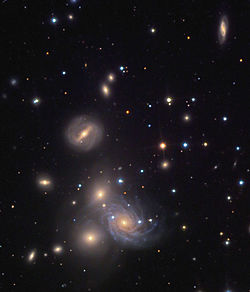| NGC 67 | |
|---|---|
NGC 67 (red arrow) and NGC 67a to the right, within the NGC 68 group | |
| Observation data (J2000 epoch) | |
| Constellation | Andromeda |
| Right ascension | 00h 18m 12.2s[1] |
| Declination | +30° 03′ 20″[1] |
| Redshift | 0.020734[1] |
| Heliocentric radial velocity | 6216 km/s[1] |
| Distance | 275,000,000 ly[2][3] |
| Group or cluster | NGC 68 group |
| Apparent magnitude (V) | 14.2[3][4] |
| Characteristics | |
| Type | E5[4] |
| Size | 40,000[3] |
| Apparent size (V) | 24" x 12"[4] |
| Other designations | |
| PGC 138159[1] | |
| NGC 67a | |
|---|---|
 image of NGC 67a from the 2MASS survey | |
| Observation data (J2000 epoch) | |
| Constellation | Andromeda |
| Right ascension | 00h 18m 14.8s[5] |
| Declination | +30° 03′ 47″ |
| Redshift | 0.022162[5] |
| Heliocentric radial velocity | 6644 km/s[5] |
| Distance | 300,000,000 ly[2] |
| Group or cluster | NGC 68 group |
| Apparent magnitude (V) | 14.5 |
| Characteristics | |
| Type | E3 |
| Size | 35,000 |
| Apparent size (V) | 0.49′ × 0.331′[6] |
| Other designations | |
| PGC 1185[5] | |
NGC 67 is an elliptical galaxy located in the constellation Andromeda that was discovered on October 7, 1855, by R. J. Mitchell, who described it as "extremely faint, very small, round". The galaxy belongs to the NGC 68 group, which also contains the galaxies NGC 68, NGC 69, NGC 70, NGC 71, NGC 72, and possibly NGC 74.
- ^ a b c d e "NED search results for NGC 67". NASA/IPAC Extragalactic Database. NED. Retrieved 13 May 2014.
- ^ a b Wright, Ned. "Ned Wright's Javascript Cosmology Calculator". UCLA. Retrieved 13 May 2014.
- ^ a b c "New General Catalog Objects: NGC 50 - 99". cseligman.com. Retrieved 13 May 2014.
- ^ a b c "NGC 67 > Deep Sky Objects Browser". dso-broser.com. DSO Browser. Archived from the original on 3 April 2015. Retrieved 13 May 2014.
- ^ a b c d "NED search results for PGC 001185". NASA/IPAC Extragalactic Database. NED. Retrieved 30 August 2021.
- ^ "PGC 138159 - Galaxy - WIKISKY". WIKISKY. Retrieved 13 May 2014.
